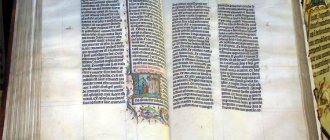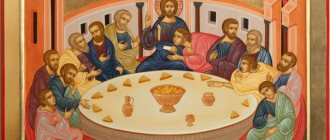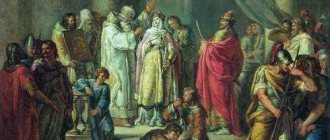B bible. When we hear this word, what analogies, ideas and parallels do we have?
We know that the Bible is a book, or rather, it is a collection of several books. The Bible is called "Scripture" or "Holy Scripture" and "the Word of God" - which is how it differs from other books. The Bible is God's message to humanity; He wanted to share with us information about Himself, about His Word, information about His creation. He wants to communicate with us and for this He created this Book. He has a Word to us.
John 1:1,2 says this:
“In the beginning was the Word, and the Word was with God, and the Word was God. It was in the beginning with God."
Let's take a quick look at the history, structure, and significance of this book.
History of the Bible
The Bible was written over fifteen centuries. It was written in letters, although early peoples used hieroglyphs and cuneiform for writing, i.e. depicted a story.
The Bible is divided into two parts: the Old (old) Testament and the New Testament (Gospel - “good news”). The books of the Old Testament were written in Hebrew, in the Phoenician alphabet, with capital consonants expressing the essence of the word. The books were written on scrolls made of tanned leather, using sharpened reeds and ink.
The words were not always separated from each other, much less there were chapters and verses. All books of the New Testament were written in ancient Greek. In 1228, Archbishop Stephen Langton created the chapter system, and in 1551, the Parisian Bible publisher Robert Etienne divided the chapters into verses.
The biblical text was written on three continents: Europe, Asia and Africa. About 45 people wrote the Bible. They had different origins, different status in society, and professions. Among them were: fishermen, military leaders, prophets, kings, shepherds, a tent maker, a doctor, a tax collector, etc. They differed from each other in culture, education, and abilities.
Of course, the author of the Bible is God Himself, but it was written by people under the influence of God’s Spirit, as we can read about in 2 Peter 1:19-21
“And moreover, we have a most sure prophetic word; and you do well to turn to him as to a lamp shining in a dark place, until the day dawns and the morning dawns in your hearts, knowing first of all this, that no prophecy in Scripture can be resolved (“created”). by yourself. For prophecy was never made by the will of man, but holy men of God spoke it, being moved by the Holy Spirit.”
God Himself, through His Spirit, gave His chosen people the ability to receive revelation from Him and, using their individuality, their style of expression, their language, spoke and wrote down His revelation to humanity through these people. But not only were the writers moved by the Spirit, the very text of Scripture breathes it, as we can see for ourselves by reading this book today.
Holy Bible
So that the Revelation given by God was unchanging, accurate and could be passed on from generation to generation (from generation to generation), the Lord gave people the Holy Scriptures . God revealed Himself and His will through the prophets. He commanded them to write down everything that He proclaims to the representatives of the chosen people: Now go, write it on their board, and write it in a book, so that it will remain for the future, forever, forever (Is 30:8).
The Bible consists of the sacred books of the Old and New Testaments , which contain Divine revelation about God, the world and our salvation. Through them, God gradually (as humanity matured spiritually) revealed truths. The greatest of them is about the Savior of the world. Jesus Christ is the spiritual heart of the Bible. His incarnation, death on the cross for our sins and resurrection are the main events of not only Sacred, but world history. Jesus Christ spiritually unites both Testaments. The Old Testament speaks of His expectation, and the New Testament speaks of the fulfillment of this expectation. The Savior said to the Jews: Search the Scriptures, for through them you think you have eternal life; and they testify of Me (John 5:39).
The most important distinguishing feature of biblical books is historicity . The Lord has communicated saving truths to chosen people for over a thousand years in specific life circumstances. More than fifteen centuries have passed from the epiphanies witnessed by Patriarch Abraham to the revelations given to the last Old Testament prophet Malachi. Among those whom the Lord chose to become witnesses of the Truth were: wise men (Moses), shepherds (Amos), kings (David, Solomon), warriors (Joshua), judges (Samuel), priests (Ezekiel). With such a great variety of personal, historical, geographical, cultural, national and other circumstances and conditions, the amazing unity of all biblical sacred texts . They are completely consistent with each other and complement each other . All of them are organically woven into the historical fabric of real historical life. A holistic look at the history of biblical revelations reveals to us the paths of Divine Providence with all impressive clarity.
Reading the Bible should begin with the Gospel, then turn to the Acts of the Apostles and the Epistles. And only after understanding the New Testament books should one proceed to the Old Testament. Then the meaning of the prototypes, pre-images and symbols will be clear, containing prophecies about the coming of the Savior into the world, His preaching, atoning death and resurrection.
In order to perceive the word of God undistorted, it is necessary to turn to the interpretations of the works of the holy fathers and Orthodox researchers, based on their heritage.
Inspiration of Holy Scripture
Sacred books are usually called inspired . From many places in the Bible it is clear that this main feature of it is the result of the influence of the Spirit of God on the human spirit - on the minds and hearts of people chosen and sanctified for a special service. At the same time, God preserves and gives the opportunity to manifest individual human characteristics . Studying the books written by Moses, Joshua, David, Solomon, Isaiah and other prophets, it is easy to see their personality traits, character traits, and style features . Their human word did not disappear, did not dissolve in the word of God, but quite definitely manifested itself, giving an individual coloring to the sacred texts.
Sermon of Christ in the synagogue of Nazareth. Serbia, Vysoki Decani monastery
At the same time, the Divine truth was not diminished one iota: All Scripture is inspired by God and is profitable for teaching, for reproof, for correction, for instruction in righteousness (2 Tim. 3:16).
Who wrote the Bible
Its authors were holy people - prophets (Old Testament) and apostles (New Testament). The Lord Himself chose and called them. Contemporaries knew that these were God's people, and therefore their texts were treated as the word of God .
There was no need to collect Bible books. These scrolls were kept first in the tabernacle, and then in the Jerusalem temple. Sacred manuscripts were also in the synagogues (houses of prayer of the Jews), which are mentioned in the Holy Gospel.
Canon of Holy Scripture
The word canon translated from Greek means rule, measure, sample. This was the name of the cane that builders used as a measuring stick. When applied to the Holy Scriptures, canonical means correct, true. Therefore, these are books recognized by the Church as the revelation of God.
How did the canon come about? Already during the life of the prophets, believing Jews recognized them as God's messengers. Their books were read, rewritten and passed on from generation to generation. The last inspired men of the Jewish people are Ezra, Nehemiah and Malachi. They lived in the middle of the 5th century BC. Through their works the canon of sacred books was finally formalized. The inspired texts were compiled into a single corpus and divided into sections: Law, Prophets and Scriptures .
This collection of sacred books of the Old Testament was adopted by the New Testament Church . The composition of the canonical books is the same, but they are distributed not into three, but into four sections.
Prophets David, Daniel and Solomon. Russia, Kirillo-Belozersky Monastery
The law (or legal books) contained Divine instructions and determined all aspects of the life of the chosen people - religious, moral, legal. He precisely defined the relationship of man to God and between people. The purpose of the laws was to educate the people in piety and obedience to God. The ultimate goal is to be a teacher to Christ (see: Gal 3:24), that is, to protect the people from the temptations of polytheism and pagan vices and prepare them for the coming of the Savior.
Historical books teach us to see the paths of Divine Providence leading humanity to salvation. They show how the Lord decides the destinies of not only individual nations, but also of every person. The idea that the well-being of the people depends on fidelity to the Law of God runs through all the biblical historical books as a core. Apostasy from God leads to national disasters. The way to get rid of them is repentance and correction of life.
Educational books instruct in faith and provide lessons in spiritual wisdom. They talk about Divine love and benefits, about the immutability of His promises. They teach thanksgiving, fear of God, prayer, fighting sin and repentance. Educational books reveal the meaning and ultimate goal of human life - righteousness and life with God. The psalmist David turns to the Lord: fullness of joy is before You, blessedness is at Your right hand forever (Ps 15:11).
Prophetic books explain the meaning of the Covenant and the law for pleasing God and fulfilling the commandments. The prophets were messengers of the will of God, guardians of true knowledge of God. They heralded the Coming of the coming Savior of the world and the establishment of the eternal Kingdom of God. Prophetic books are a spiritual bridge between the Old and New Testaments. In the Old Testament books, the most important New Testament events were predicted by prophecies, symbols and types. “The New Testament is hidden in the Old, the Old is revealed in the New,” says St. Augustine.
The composition of the Holy Scriptures of the Old Testament established by the Orthodox Church includes fifty books: thirty-nine canonical and eleven non-canonical .
Non-canonical books were written by reverent people, but they did not grasp the meaning of texts created directly by the inspiration of the Holy Spirit. Created by spiritually experienced people, they are edifying and intended for moral reading. For this reason, the Christian Church from ancient times intended them for the benefit of their children. For example, St. Athanasius the Great (IV century) speaks about this in his 39th Feast Epistle. Having listed the canonical books, he adds: “For greater accuracy, I add that besides these books there are others that are not included in the canon, which, however, were established by the fathers to be read by those who are newly coming and who wish to be instructed in the word of piety, these are: the Wisdom of Solomon, the Wisdom of Sirach, Esther, Judith, Tobias" (Creations. M., 1994. T. 3. P. 372).
All canonical Old Testament books were written in Hebrew . Only some sections of the books of the prophet Daniel and Ezra, written during and after the Babylonian captivity, are compiled in Aramaic .
All New Testament holy books (four Gospels, the Acts of the Holy Apostles, fourteen Epistles of the Apostle Paul, seven cathedral epistles) were written by the apostles during the 1st century AD. The most recent is the Revelation (Apocalypse) of the Apostle and Evangelist John the Theologian (c. 95 –96). Our confidence in the Divine origin of the books of the New Testament is based on the words of the Savior. On the eve of His suffering on the cross, He told the disciples that His Father will send the Holy Spirit, who will teach you everything and remind you of everything that I have told you (John 14:26).
Christian communities perceived as the word of God not only the Gospel, but also the Acts of the Holy Apostles and the Epistles. There are direct indications of this in the texts: I received from the Lord Himself what I also passed on to you (1 Cor 11:23); This we say to you by the word of the Lord (1 Thessalonians 4:15). Already in apostolic times, the Churches transmitted to each other the messages of the apostles addressed to them (see: Col. 4, 16). Members of the primal Church knew the sacred New Testament texts well. From generation to generation, sacred books were reverently read and carefully preserved.
Already by the middle of the 2nd century, all four of our canonical Gospels were known in all Churches and only they were recognized as Holy Scripture. A Christian writer named Tatian, who lived at that time, made an attempt to combine all four Gospels into a single narrative (he called his work “Diatessaron”, that is, “According to the Four”). However, the Church chose to use all four Gospel texts as they were written by the apostles and evangelists. Hieromartyr Irenaeus of Lyons (2nd century) wrote: “It is impossible for the Gospels to be more or less in number than there are. For since there are four directions of the world in which we live, and four main winds, and since the Church is scattered throughout the whole earth, and the pillar and foundation of the Church is the Gospel and the Spirit of life, then it must have four pillars, spreading incorruption from everywhere and reviving people "(Against heresies. Book 3, chapter 11).
The New Testament holy books were written in Greek . Only the evangelist Matthew, according to the testimony of the historian of the early Church Papias of Hierapolis (d. 160 A.D.), wrote down the words of his Teacher Jesus Christ in Hebrew , then his work was translated into Greek.
The Holy Scriptures of the Old and New Testaments formed a single book - the Holy Bible, which has been translated into all languages and is the most read book in the world.
Structure of the Bible
The Bible has 66 books (canon): 39 books of the Old Testament (written between 1500-400 BC) and 27 books of the New Testament (written between 45-95 AD). There is no name “Old Testament” in Jewish literature; Jews call all Scripture Tanakh (Talmud - comments on the Tanakh).
The Tanach is divided into 3 parts:
a ) Law ( Torah ) – Genesis, Exodus, Leviticus, Numbers, Deuteronomy;
b ) Prophets ( Nebiim ) - the books of Joshua, Judges, 4 books of Kings, books of the later prophets (Isaiah, Jeremiah) and 12 books of minor prophets;
c ) Scriptures ( Ketubim and sacred scriptures ) - Psalms, Proverbs, Job, Song of Songs, Ruth, Lamentations, Ecclesiastes, Esther, Daniel, Ezra, Nehemiah and 2 Chronicles.
The books of the New Testament begin with the 4 Gospels, which describe the birth, life, ministry, death, resurrection, ascension of Jesus Christ and His teaching of disciples who were to continue His work after the ascension.
The book of Acts of the Apostles describes the emergence of the church on the Day of Pentecost and the beginning of the spread of the gospel message throughout the world through the ministry of the apostles.
Epistles (letters) are divided into general (conciliar) and epistles of the Apostle Paul (Shaul) - 14.
The New Testament ends with the book of the Revelation of John (Apocalypse), which contains a narrative of eschatological events.
Who wrote the New Testament
New Testament scholars have just as many questions. The more detailed they reread the canon of Gospels, the more often the question arose: how much was actually written by Jesus’ companions - the apostles? None of the gospel texts (the exception is the Gospel of John) contains a description of the author’s personality. So perhaps we only have the retellings that were written down by those who studied with the apostles and would like to preserve and record their stories for posterity?
The peculiarities of the style in which these texts were written pushed a large number of theologians to the idea that they could not have been created earlier than the second half of the 1st century. In the modern world, biblical scholars fully agree that the Gospels were written by anonymous authors who had the stories of the apostles themselves at their disposal, as well as some text that has not survived to this day, scientists nicknamed it “Source 0”. This source was not a gospel story, but rather was a semblance of a collection of Jesus’ words, which were most likely recorded by direct listeners of his sermons.
The general consensus among Bible scholars is that Mark was the first gospel to be written. This was around the 60s and 70s. Next, on its basis, the Gospels of Matthew (70-90s) and Luke (80-100s) were written. Actually, that’s why the texts of all these stories are so close. The Gospel of John was created around 80-95 and was written apart from everyone. In addition, the author of the Gospel of Luke was most likely the author of the Acts of the Apostles. Later, instead of the names of the authors, “holy authors” were added.
Holy Spirit and the human spirit
It is important to see that people created by God not only have a mind, but also another internal part that is deeper than the mind. In the Bible, in Zech. 12:1 says that God “formed the spirit of man within him.” The “spirit of man” is our deepest part. Just like other parts of our being, it has its own special function. Our eyes exist to see, our ears exist to hear, and our human spirit exists to touch, receive, and contain God.
John 4:24 says:
God is Spirit, and those who worship Him must worship in spirit...
In this verse, the first word “Spirit” refers to the divine Spirit, and the second word refers to the human spirit. Through our human spirit we can worship God, have fellowship with God, and know God who is Spirit.
So what does this have to do with the origins of the Bible? When some people had fellowship with God in their spirit, they were moved, or carried, by the Holy Spirit to write down not their own words, but the words of God. The Scriptures are God's words, and they are holy because their source is God. They came to us from people moved by the Holy Spirit to speak and write words from God.
Report No. 2
The Bible is the oldest book and it is sacred in the Christian religion. They wrote it a couple of thousand years ago. It tells about the creation of the world, the Garden of Eden and the first people on Earth - Adam and Eve, and much more.
The Bible is divided into the Old Testament and the New Testament. The Old Testament describes the history of the life and ordeals of the Jewish people. This part of the Bible is also a holy book for the Jewish religion. It contains instructive stories that showed the cruelty and truthfulness of the life of the entire Jewish people. Each chapter is a separate story that reflects both fictional and true historical facts.
The Bible spells out the moral laws and beliefs by which humanity needs to exist. The Ten Commandments are set out in the Old Testament: do not kill, do not steal, do not commit adultery, respect your father and mother. The New Testament also contains many important life laws and instructive stories that became the basis for the Christian religion.
The New Testament describes the story of the birth and life of Jesus Christ, the Son of God. He taught people to do good, raised the dead, and cured the sick. Ordinary people followed him with admiration and greeted him with respect in their own homes. He had many disciples who carried his teachings to the people. But the priests and rulers saw in Jesus a danger to religion and power. They were afraid that ordinary people would obey the Son of God and follow him.
Jesus' disciple Judas sold his own mentor to his enemies for 13 pieces of silver. Jesus was tried and then crucified on Mount Golgotha. But the Son of God rose again and appeared before his followers, and thereby proved that his teaching was fair and correct.
The Bible is a very fascinating book from which you can get a lot of meaningful and useful information. Many authors use episodes from the Bible to create their works: Pushkin A.S., Bulgakov M.A. and other Russian and foreign authors.
Two languages - two parts
It is common to see such a division: the first part is from Genesis to Malachi and the second is from Matthew to Revelation. Since they were written over the centuries, the languages spoken by the people who respect this book changed. Therefore, the question of what language the Bible was written in should be approached in detail: the Old Testament (first part) was written mainly in Hebrew (some passages in Aramaic), and the New Testament (second part) in Greek.
Naturally, over time, being under the yoke of other peoples, the Jews adopted their language. Now for most of them the Bible in Hebrew has ceased to be understandable. They spoke Greek, and while previous generations still understood the Scriptures, those who grew up in captivity already needed the Bible in Greek.
Popular message topics
- City of Kostroma
Kostroma is an ancient Russian city that was founded back in the 12th century. But, a century later, it was formed as an independent, appanage principality. The origin of the city is connected with the activities of Prince Yuri Dolgoruky. - Cell structure and division
A cell is an elementary part of an organism that can itself exist, self-reproduce and develop. It is a fundamental element of all living things, both organisms and plants. Cells can be independent organisms. - The effect of alcohol on the human nervous system
The path of ethanol from the human digestive system to the circulatory system takes approximately two minutes. From the circulatory system, alcohol also quickly enters the nervous system and its most important component - the brain.
Septuagint
The need for a new translation was very clearly felt among the Jewish people, and 72 people were gathered who understood both languages well and set to work. The goal was to translate the Scriptures from Biblical Hebrew into common Greek. As a result, the entire Hebrew Scriptures in Greek became accessible to the people by the end of the 2nd century BC. e. The translation gained universal acceptance and became frequently used. It was later named after the number of translators: "Septuagint", which means the number 70.
Other translations were created based on it. Thus, the Vatican Codex, which was based on the Septuagint and included most of the Hebrew and Greek Scriptures, is very respected and reliable. It was completed in the 4th century AD. e., but for a long time it was inaccessible to even eminent scientists. Later the Sinaiticus and Alexandrian codes appeared. However, along with the spread of various translations, an increasing number of errors began to appear. If one thought was originally written in Hebrew, then in more modern translations it could take on a completely different meaning or turn into another, which is why the biblical stories themselves were distorted.
Knowing the source is essential
We usually check the origin of something we want to be sure about. For example, it is always important for us to know where the water we drink comes from. If we know that it is from a pure source, then we are sure that it can be drunk without harm to health. Likewise, we believe the news if we believe that the journalists can be trusted and the facts they present have been verified.
Knowing the source helps us evaluate the credibility of something. If we know the source of something, we either disregard it or consider it valuable and trustworthy. A lot depends on the source. The same is true of the Bible.










